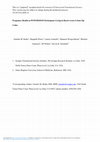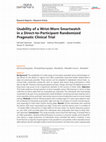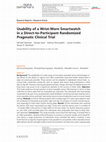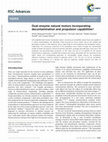Papers by Michael Galarnyk
Circulation, 2019
Introduction: Heart rate is routinely measured but is rarely acted upon unless well out of a popu... more Introduction: Heart rate is routinely measured but is rarely acted upon unless well out of a population-based normal range. In the era of wearable sensor technologies, heart rate can be continuousl...
PLOS ONE, 2020
Background Heart rate is routinely measured as part of the clinical examination but is rarely act... more Background Heart rate is routinely measured as part of the clinical examination but is rarely acted upon unless it is well outside a population-based normal range. With wearable sensor technologies, heart rate can now be continuously measured, making it possible to accurately identify an individual's "normal" heart rate and potentially important variations in it over time. Our objective is to describe inter-and intra-individual variability in resting heart rate (RHR) collected over the course of two years using a wearable device, studying the variations of resting heart rate as a function of time of year, as well as individuals characteristics like age, sex, average sleep duration, and body mass index (BMI).

Journal of Clinical and Translational Science, 2020
Background: Pregnant women living in rural locations in the USA have higher rates of maternal and... more Background: Pregnant women living in rural locations in the USA have higher rates of maternal and infant mortality compared to their urban counterparts. One factor contributing to this disparity may be lack of representation of rural women in traditional clinical research studies of pregnancy. Barriers to participation often include transportation to research facilities, which are typically located in urban centers, childcare, and inability to participate during nonwork hours. Methods: POWERMOM is a digital research app which allows participants to share both survey and sensor data during their pregnancy. Through non-targeted, national outreach a study population of 3612 participants (591 from rural zip codes and 3021 from urban zip codes) have been enrolled so far in the study, beginning on March 16, 2017, through September 20, 2019. Results: On average rural participants in our study were younger, had higher pre-pregnancy weights, were less racially diverse, and were more likely t...

Digital Biomarkers, 2019
Background: The availability of a wide range of innovative wearable sensor technologies today all... more Background: The availability of a wide range of innovative wearable sensor technologies today allows for the ability to capture and collect potentially important health-related data in ways not previously possible. These sensors can be adopted in digitalized clinical trials, i.e., clinical trials conducted outside the clinic to capture data about study participants in their day-today life. However, having participants activate, charge, and wear the digital sensors for long hours may prove to be a significant obstacle to the success of these trials. Objective: This study explores a broad question of wrist-wearable sensor effectiveness in terms of data collection as well as data that are analyzable per individual. The individuals who had already consented to be part of an asymptomatic atrial fibrillation screening trial were directly sent a wrist-wearable activity and heart rate tracker device to be activated and used in a home-based setting. Methods: A total of 230 participants with a median age of 71 years were asked to wear the wristband as frequently as possible, night and day, for at least a 4-month monitoring period, especially to track heart rhythm during sleep. Results: Of the individuals who received the device, 43% never transmitted any data. Those who used the device wore it a median of ∼15 weeks (IQR 2-24) and for 5.3 days (IQR 3.2-6.5) per week. For rhythm detection purposes, only 5.6% of all recorded data from individuals were analyzable (with beat-to-beat intervals reported). Conclusions: This study provides some important learnings. It showed that in an older population, despite initial enthusiasm to receive a consumer-quality wrist-based fitness device, a large proportion of individuals never activated the device. However, it also found that for a majority of participants it was possible to successfully collect wearable sensor data without clinical oversight inside a home environment, and that once used, ongoing wear

Digital Biomarkers, 2019
Background: The availability of a wide range of innovative wearable sensor technologies today all... more Background: The availability of a wide range of innovative wearable sensor technologies today allows for the ability to capture and collect potentially important health-related data in ways not previously possible. These sensors can be adopted in digitalized clinical trials, i.e., clinical trials conducted outside the clinic to capture data about study participants in their day-to-day life. However, having participants activate, charge, and wear the digital sensors for long hours may prove to be a significant obstacle to the success of these trials. Objective: This study explores a broad question of wrist-wearable sensor effectiveness in terms of data collection as well as data that are analyzable per individual. The individuals who had already consented to be part of an asymptomatic atrial fibrillation screening trial were directly sent a wrist-wearable activity and heart rate tracker device to be activated and used in a home-based setting. Methods: A total of 230 participants with a median age of 71 years were asked to wear the wristband as frequently as possible, night and day, for at least a 4-month monitoring period, especially to track heart rhythm during sleep. Results: Of the individuals who received the device, 43% never transmitted any data. Those who used the device wore it a median of ∼15 weeks (IQR 2–24) and for 5.3 days (IQR 3.2–6.5) per week. For rhythm detection purposes, only 5.6% of all recorded data from individuals were analyzable (with beat-to-beat intervals reported). Conclusions: This study provides some important learnings. It showed that in an older population, despite initial enthusiasm to receive a consumer-quality wrist-based fitness device, a large proportion of individuals never activated the device. However, it also found that for a majority of participants it was possible to successfully collect wearable sensor data without clinical oversight inside a home environment, and that once used, ongoing wear time was high. This suggests that a critical barrier to overcome when incorporating a wearable device into clinical research is making its initiation of use as easy as possible for the participant.
Attempts to apply artificial nano/micromotors for diverse biomedical applications have inspired a... more Attempts to apply artificial nano/micromotors for diverse biomedical applications have inspired a variety of strategies for designing motors with diverse propulsion mechanisms and functions.

Self-propelled dual-function biocatalytic motors, consisting of unmodified natural tissue and cap... more Self-propelled dual-function biocatalytic motors, consisting of unmodified natural tissue and capable of in-motion bioremediation, are described. These enzyme-rich tissue motors rely on the catalase and peroxidase activities of their Raphanus sativus radish body for their propulsion and remediation actions, respectively. The continuous movement of the biocatalytic tissue motors through the contaminated sample facilitates the dynamic removal of phenolic pollutants. Hydrogen peroxide plays a dual role in the propulsion and decontamination processes, as the motor fuel and as co-substrate for the phenol transformation, respectively. Localized fluid transport and mixing, associated with the movement of the radish motors and corresponding generation of microbubbles, greatly improve the remediation efficiency resulting in maximal removal of pollutants within 3 min. The new 'on-the-fly' remediation process is cost effective as it obviates the need for expensive isolated enzymes and relies on environmental-friendly plant tissues.
This work reports on the coupling of antibody-functionalized micromotors and microwire-tagged pro... more This work reports on the coupling of antibody-functionalized micromotors and microwire-tagged proteins for rapid and multiplexed immunoassays. While micromotor-induced mixing accelerates the immunoreaction, tagging the proteins with microscopic particles of different sizes and shapes allows for their multiplexed discrimination, alerting of the presence of a biological threat.
Towards addressing the need for detecting and eliminating biothreats, we describe a micromotor-ba... more Towards addressing the need for detecting and eliminating biothreats, we describe a micromotor-based approach for screening, capturing, isolating and destroying anthrax simulant spores in a simple and rapid manner with minimal sample processing. The B. globilli antibody-functionalized micromotors can recognize, capture and transport B. globigii spores in environmental matrices, while showing non-interactions with excess of non-target bacteria.
Fluid convection and mixing induced by bubble-propelled tubular microengines are characterized us... more Fluid convection and mixing induced by bubble-propelled tubular microengines are characterized using passive microsphere tracers. Enhanced transport of the passive tracers by bubble-propelled micromotors, indicated by their mean squared displacement (MSD), is dramatically larger than that observed in the presence of catalytic nanowires and Janus particle motors. Bubble generation is shown to play a dominant role in the effective fluid transport observed in the presence of tubular microengines. These findings further support the potential of using bubble-propelled microengines for mixing reagents and accelerating reaction rates. The study offers useful insights toward understanding the role of the motion of multiple micromotors, bubble generation, and additional factors (e.g., motor density and fuel concentration) upon the observed motor-induced fluid transport.
Teaching Documents by Michael Galarnyk
Link to youtube tutorial: https://www.youtube.com/watch?v=B6d5LrA8bNE
Guide on how to install Py... more Link to youtube tutorial: https://www.youtube.com/watch?v=B6d5LrA8bNE
Guide on how to install PySpark on Mac + Configure Jupyter Notebook + Word Count
Link to Youtube Video: https://www.youtube.com/watch?v=uhVYTNEe_-A










Uploads
Papers by Michael Galarnyk
Teaching Documents by Michael Galarnyk
youtube video: https://www.youtube.com/watch?v=71iXeuKFcQM
Logistic Regression Jupyter Notebook (Digits Dataset): https://github.com/mGalarnyk/Python_Tutorials/blob/master/Sklearn/Logistic_Regression/LogisticRegression_toy_digits.ipynb
Logistic Regression Jupyter Notebook (MNIST Dataset): https://github.com/mGalarnyk/Python_Tutorials/blob/master/Sklearn/Logistic_Regression/LogisticRegression_MNIST.ipynb
Guide on how to install PySpark on Mac + Configure Jupyter Notebook + Word Count
Link to Code: https://github.com/mGalarnyk/Python_Tutorials/blob/master/Request/Heat%20Maps%20using%20Matplotlib%20and%20Seaborn.ipynb
Youtube Video:
https://www.youtube.com/watch?v=m7uXFyPN2Sk
Link to youtube video: https://www.youtube.com/watch?v=1S5UKLqe-gg
This code demonstrates how to view time series data in pandas as well as shifting dataframe, groupby datetime (daily, weekly, monthly), and price variation by day, month, year etc.
youtube video: https://www.youtube.com/watch?v=71iXeuKFcQM
Logistic Regression Jupyter Notebook (Digits Dataset): https://github.com/mGalarnyk/Python_Tutorials/blob/master/Sklearn/Logistic_Regression/LogisticRegression_toy_digits.ipynb
Logistic Regression Jupyter Notebook (MNIST Dataset): https://github.com/mGalarnyk/Python_Tutorials/blob/master/Sklearn/Logistic_Regression/LogisticRegression_MNIST.ipynb
Guide on how to install PySpark on Mac + Configure Jupyter Notebook + Word Count
Link to Code: https://github.com/mGalarnyk/Python_Tutorials/blob/master/Request/Heat%20Maps%20using%20Matplotlib%20and%20Seaborn.ipynb
Youtube Video:
https://www.youtube.com/watch?v=m7uXFyPN2Sk
Link to youtube video: https://www.youtube.com/watch?v=1S5UKLqe-gg
This code demonstrates how to view time series data in pandas as well as shifting dataframe, groupby datetime (daily, weekly, monthly), and price variation by day, month, year etc.
Link to youtube video:
https://www.youtube.com/watch?v=OwnaUVt6VVE
Viewing Pandas DataFrame, Adding Columns in Pandas, Plotting Two Pandas Columns, Sampling Using Pandas, Rolling mean in Pandas (Smoothing), Subplots, Plotting against Date (numpy.datatime), Filtering DataFrame in Pandas, Simple Joins, and Linear Regression.
This tutorial is mostly focused on manipulating time series data in the Pandas Python Library.
To download the dataset, go to:
http://attributes.kyb.tuebingen.mpg.de/AwA-base.tar.bz2
This Document is also available in ipython notebook format at:
https://github.com/mGalarnyk/DSE210_Probability_Statistics_Python/blob/master/K-Means%2C%20PCA%2C%20and%20Dendrogram%20on%20the%20Animals%20with%20Attributes%20Dataset.ipynb
About the dataset: This is a small dataset that has information on about 50 animals. The animals are listed in classes.txt. For each animal, the information consists of values for 85 features: does the animal have a tail, is it slow, does it have tusks, etc. The details of the features are in the predicates.txt. The full data consists of a 50 x 85 matrix of real values, in predicate-matrix-continuous.txt. There is also a binarized version of this data, in predicate-matrix-binary.txt.
This document goes over K-Means, PCA, and Hierarchical Clustering of the Animals with Attributes Dataset.
Download the IRIS data set from: https://archive.ics.uci.edu/ml/machine-learning-databases/iris/iris.data
This is a data set of 150 points in R4, with three classes; refer to the website for more details of the
features and classes.
(a) Use a PCA projection to 2d to visualize the entire data set. You should plot different classes using
different colors/shapes. Do the classes seem well-separated from each other? (b) Now build a classifier for this data set, based on a generative model.
Quick tutorial on how to convert ipynb to pdf and html format on Mac OS X
MacTeX Download: https://tug.org/mactex/mactex-download.html
Official Documentation: https://ipython.org/ipython-doc/1/interactive/nbconvert.html
https://github.com/mGalarnyk/Python_Tutorials/blob/master/Python_Basics/Linear_Regression/Linear_Regression_Python.ipynb
Defining matrices, multiplying matrices, finding the inverse etc
https://github.com/mGalarnyk/linear-algebra.git